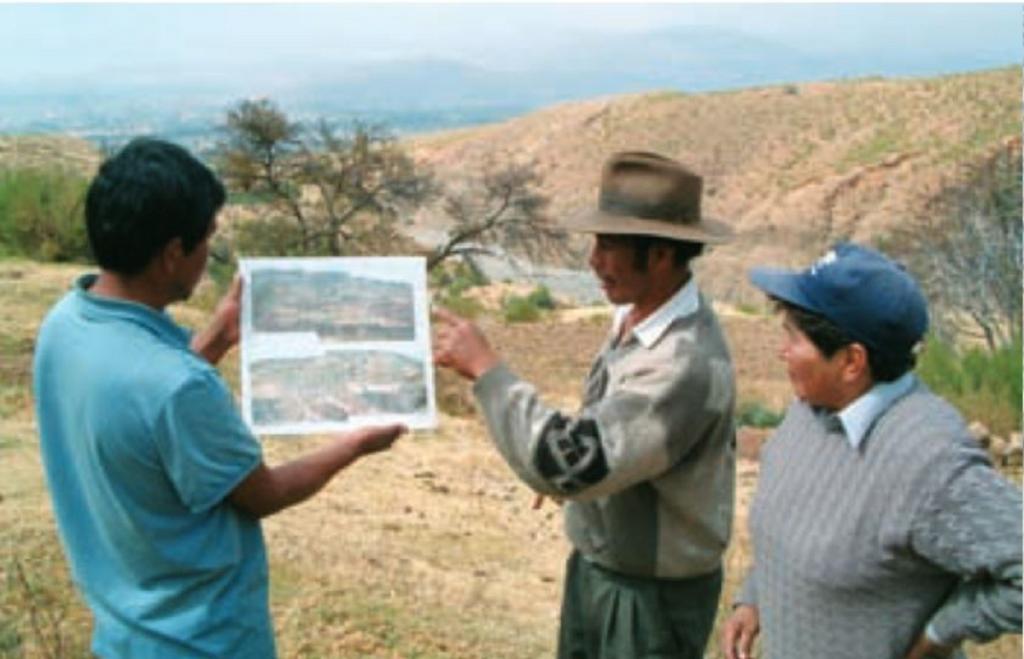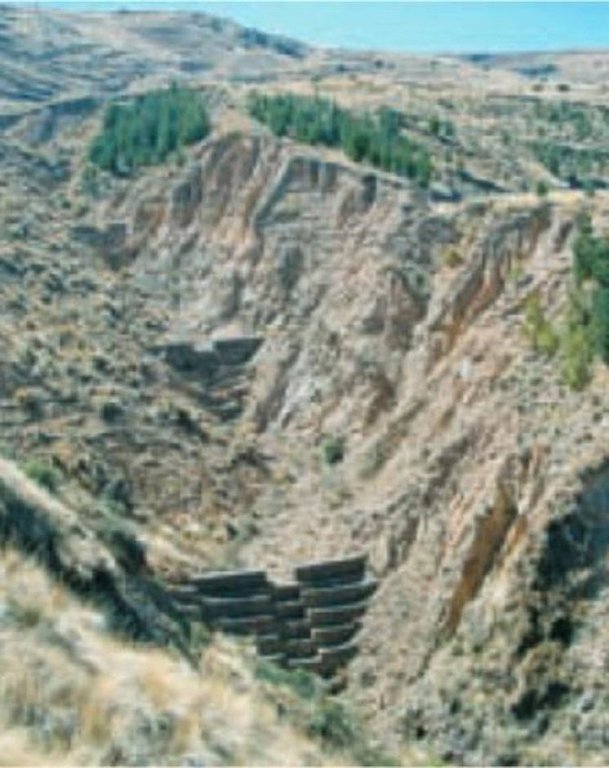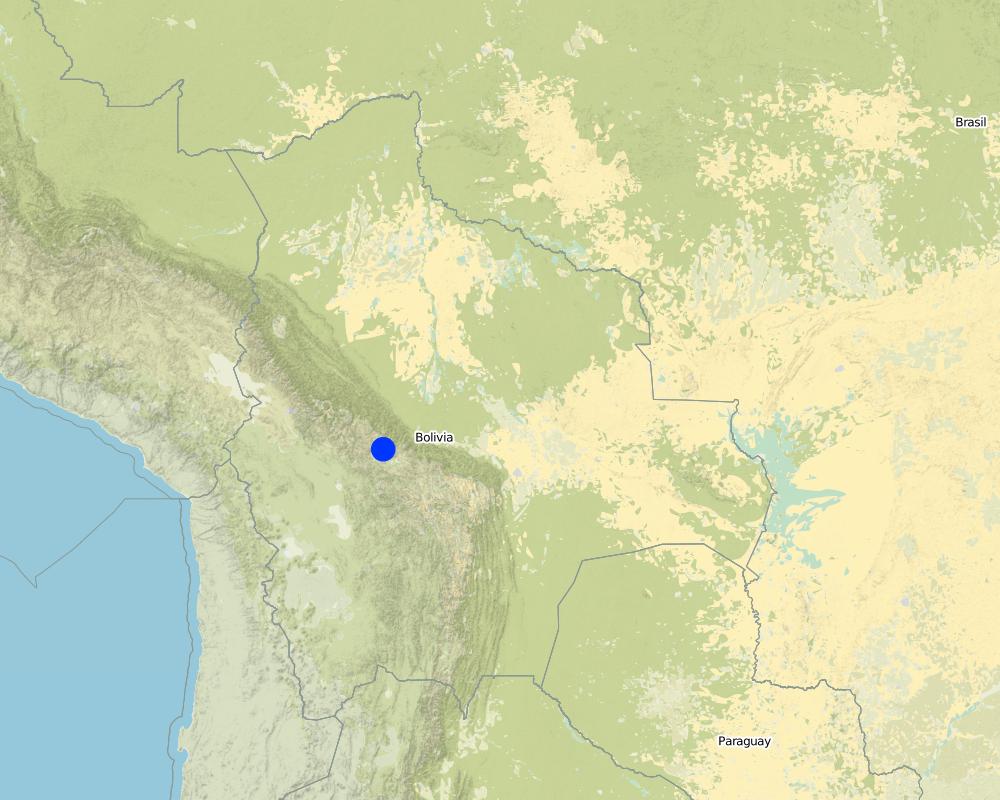Incentive-based catchment treatment [بوليفيا، دولة بوليفيا المتعددة القوميات]
- تاريخ الإنشاء:
- تحديث:
- جامع المعلومات: Unknown User
- المحرر: –
- المراجعون: David Streiff, Deborah Niggli
approaches_2404 - بوليفيا، دولة بوليفيا المتعددة القوميات
عرض الأقسام
توسيع الكل طي الكل1. معلومات عامة
1.2 تفاصيل الاتصال بالأشخاص الرئيسيين لمصدر المعلومات والمؤسسات المعنية بتقييم وتوثيق النهج
متخصص في الإدارة المستدامة للأراضي:
اسم المشروع الذي سهّل توثيق/تقييم النهج (إذا كان ذلك على صلة)
Book project: where the land is greener - Case Studies and Analysis of Soil and Water Conservation Initiatives Worldwide (where the land is greener)اسم المؤسسة (المؤسسات) التي سهلت توثيق/تقييم النهج (إذا كان ذلك على صلة)
GEOTEST AG (GEOTEST AG) - سويسرا1.3 الشروط المتعلقة باستخدام البيانات الموثقة من خلال WOCAT
يوافق جامع المعلومات والشخص (لاشخاص) الرئيسي لمصدر المعلومات على الشروط المتعلقة باستخدام البيانات الموثقة من خلال WOCAT:
نعم
1.4 المراجع الخاصة باستبيان(استبيانات) تقنيات الإدارة المستدامة للأراضي

Diques de piedras [بوليفيا، دولة بوليفيا المتعددة القوميات]
Se trata de diques de piedras que se ubican en el lecho de los arroyos, acompañados por plantaciones alrededor de las construcciones.
- جامع المعلومات: Unknown User

Zanjas de Coronación [بوليفيا، دولة بوليفيا المتعددة القوميات]
Las zanjas de coronación impiden la entrada del escurrimiento superficial a las cárcavas
- جامع المعلومات: Unknown User
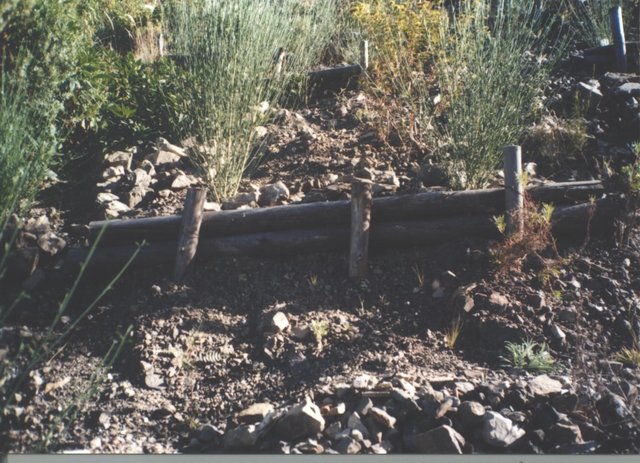
Estabilización de taludes (biotrampas) [بوليفيا، دولة بوليفيا المتعددة القوميات]
La tecnología consiste en la práctica de reforestación en combinación con el establecimiento de trampas de sedimentos (biotrampas) para consolidar los taludes.
- جامع المعلومات: Georg Heim
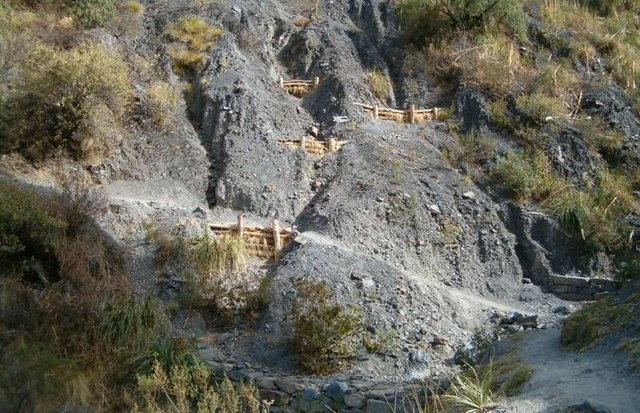
Gully control and catchment protection [بوليفيا، دولة بوليفيا المتعددة القوميات]
Integrated gully treatment consisting of several simple practices including stone and wooden check dams, cut-off drains and reforestation in sediment traps (biotrampas).
- جامع المعلومات: Georg Heim
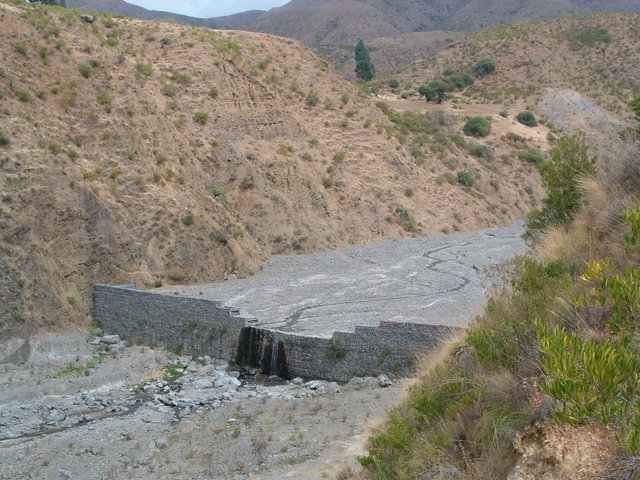
Obras Hidráulicas - Gaviones de Piedras [بوليفيا، دولة بوليفيا المتعددة القوميات]
Mampostería gavionada (= gaviones puestos en el cauce). Se trata de paquetes de piedras encajadas en malla de alambre que forman una represa de sedimentos.
- جامع المعلومات: Georg Heim

Diques de madera (tipo Krainer) [بوليفيا، دولة بوليفيا المتعددة القوميات]
Se trata de diques de madera que se ubican en el lecho de los arroyos, acompañados por plantaciones alrededor de las construcciones.
- جامع المعلومات: Georg Heim
2. وصف نهج الإدارة المستدامة للأراضي
2.1 وصف موجز للنهج
A project supported, incentive-based approach: farmers are sensitised about erosion, and involved in gully control and other measures to protect catchments.
2.2 وصف تفصيلي للنهج
وصف تفصيلي للنهج:
Aims / objectives: The objective of the locally-based organisation Programa de Manejo Integral de Cuencas (PROMIC) is to involve land users in the control of soil erosion in the catchments above Cochabamba city. While erosion here is largely a natural process, it is aggravated by inappropriate agricultural practices. PROMIC receives funds from national and international governments, and works in an interactive manner. Together with local farmers, erosion processes in the context of the human environment were analysed to identify the needs of the agriculture population - and to plan a conservation and development programme. The aim was to convince farmers of the necessity to protect their agricultural land and stabilise the gullies below, and of the overall importance of implementing technologies to combat erosion.
Role of stakeholders: The farmers were involved in the process through regular community meetings organised by PROMIC, in which they could adjust PROMIC's catchment intervention plans to their own requirements through an interactive process. PROMIC considered that the sensitisation work and the interactive process were essential to ensure long-term sustainable land use. In the short term, however, it will be mainly the city downstream - Cochabamba - that benefits from the implementation of the erosion control technologies. For that reason, the farmers were paid to carry out construction of the measures (through 'cash-for-work'). The farmers should, however, profit from the technologies in the long term. They were taught how to build and maintain check dams, cut-off drains and biotrampas. The implementation in the watershed started in 1996 and took six years: when the implementation phase was over, farmers no longer received financial subsidies. The long period of sensitisation should help to ensure that farmers incorporate erosion prevention technologies into their cropland above the gullies. PROMIC still monitors the state of the structures from time to time, but most of the maintenance is left to the farmers themselves. PROMIC continues, however, to provide technical support and some transport of materials. Both internal and external evaluation followed the end of the implementation phase.
2.3 صور عن النهج
2.5 البلد/المنطقة/المواقع التي تم تطبيق النهج فيها
البلد:
بوليفيا، دولة بوليفيا المتعددة القوميات
المنطقة/الولاية/المحافظة:
Cochabamba district
Map
×2.6 تواريخ بدء وإنهاء تنفيذ النهج
أشر إلى سنة البدء:
1996
2.7 نوع النهج
- قائم على مشروع/برنامج
2.8 الغايات/الأهداف الرئيسية للنهج
- teach farmers about sustainable land use, - build up skills amongst farmers to enable them to treat gullies without outside help, - reduce flooding and sedimentation in the valley of Cochabamba and general soil loss in the area through collaboration with farmers in the watershed, - improve traditional agriculture with a package of conservation-related practices, - indirectly support farmers by cash-for-work incentives which enables them to implement SWC technologies on their own fields
The SLM Approach addressed the following problems: - lack of knowledge about damage caused by erosion and benefits of various possible conservation technologies, - lack of financial resources: shortage of funds prevents farmers investing in technologies, even if these bring benefits to them (as well as to the downstream population), - persistence of detrimental traditional agricultural practices, leading to accelerated degradation
2.9 الظروف التي تمكن أو تعيق تنفيذ التقنية/التقنيات المطبقة بموجب النهج
توفر/الوصول إلى الموارد والخدمات المالية
- معيق
Few direct short-term profits from SWC technologies in gullies for the farmers in the watershed (the main beneficiary is the city of Cochabamba downstream).
Treatment through the SLM Approach: Search for national and international subsidies to help the farmers to implement the technologies during the initial period.
الإطار المؤسساتي
- معيق
The local farmers' association is insufficiently organised to ensure the independent continuation of activities post-project.
Treatment through the SLM Approach: Local farmers' association should be included in the sensitisation and implementation process.
غير ذلك
- معيق
Climate: Climatic extremes such as strong winds and excess or deficit of rain.
Treatment through the SLM Approach: Plant trees at close spacing, and plant trees/ shrubs that can tolerate climatic extremes.
3. المشاركة وأدوار الأطراف المعنية
3.1 أصحاب المصلحة المعنيون بالنهج وأدوارهم
- مستخدمو الأراضي المحليون/المجتمعات المحلية
There were no women working in the gully rehabilitation. The reason is a cultural taboo against women working with heavy materials; women are responsible for looking after cattle, and for the household.
- المنظمات المجتمعية
Local farmers association
- Specialised engineers of PROMIC
3.2 انخراط مستخدمي الأراضي المحليين/المجتمعات المحلية في المراحل المختلفة للنهج
| انخراط مستخدمي الأراضي المحليين/المجتمعات المحلية | حدد من شارك وصف الأنشطة | |
|---|---|---|
| المبادرة/التحفيز | سلبي | interviews/questionnaires, information during regular meetings, entrevistas / cuestionarios |
| التخطيط | تفاعلي | results of the socio-economic diagnosis defined the planning; farmers were involved through regular meetings: interactive planning at individual and community level |
| التنفيذ | الدعم الخارجي | None |
| الرصد/التقييم | سلبي | interviews/questionnaires; internal and external evaluations where farmers were interviewed |
| Research | سلبي | socio-economic diagnosis; collection and analysis of bio-physical baseline data |
3.3 مخطط التدفق (إذا كان متاحًا)
الوصف:
General assembly: National and international public and private institutions, members, foundation
Directory: Prefecture, general agent, Swiss Agency for Development and Cooperation (SDC), Belgian Technical Cooperation (BTC), private enterpreneurs
Consulting council: Municipalities, projects, universities
Advisors: General agent, marketing, SSU1, SSU2 (see below), administration
SSU: Strategic service unit
Services: Executive body for technology extension and implementation: PROMIC field technicians
3.4 اتخاذ القرار بشأن اختيار تقنية/تقنيات الإدارة المستدامة للأراضي
هل تم اتخاذ قرارات بشأن اختيار التقنية(التقنيات)؟:
- Made by specialised engineers of PROMIC
اشرح:
farmers were involved by modifying initially proposed technologies.
Decisions on the method of implementing the SLM Technology were made by Made by specialised engineers of PROMIC
4. الدعم الفني وبناء القدرات وإدارة المعرفة
4.1 بناء القدرات/التدريب
هل تم تقديم التدريب لمستخدمي الأراضي / الأطراف المعنيين الآخرين؟:
نعم
شكل التدريب:
- في العمل
المواضيع المغطاة:
The approach included training on technical aspects and on long-term planning for sustainable land use. Some farmers were trained to become foremen - who in turn instructed other farmers. During the construction period PROMIC project staff trained farmers on the job in soil conservation practices.
4.2 خدمة استشارية
هل يملك مستخدمو الأراضي وصولا إلى خدمة استشارية؟:
نعم
حدد ما إذا كانت الخدمة الاستشارية متوفرة:
- في حقول مستخدمي الأراضي
وصف/تعليقات:
Name of method used for advisory service: participatory planning of gully treatment; Key elements: making farmers aware of the environmental and economic necessity for the technology, interactive planning of technology implementation at individual and community levels
4.3 تعزيز المؤسسات (التطوير التنظيمي)
هل تم إنشاء أو تعزيز مؤسسات من خلال هذا النهج؟:
- نعم، باعتدال
حدد المستوى (المستويات) التي تم فيها تعزيز أو إنشاء المؤسسات:
- محلي
حدد نوع الدعم:
- بناء القدرات/التدريب
4.4 الرصد والتقييم
هل يشكل الرصد والتقييم جزءا من النهج؟:
نعم
التعليقات:
There were few changes in the Approach as a result of monitoring and evaluation: The approach was to initially target groups. Later, individuals were included (with individual farmer-family visits) to improve the effectiveness of the awareness raising and the implementation.
4.5 البحوث
هل كانت البحوث جزءًا من النهج؟:
نعم
حدد المواضيع:
- علم الاجتماع
- علم الايكولوجيا
- تكنولوجيا
- S
أعط تفاصيل إضافية وأشر إلى من قام بالبحوث:
Research was done on 1)SWC (testing different measures), 2)various soil parameters, and 3) a socio-economic survey. Research was an important part, not only for planning (based on biophysical and socio-economic data), but also to stay in contact with the rural population and to obtain their confidence. Thanks to the research, the technology is well adapted to the biophysical conditions.
5. التمويل والدعم المادي الخارجي
5.1 الميزانية السنوية لمكون الإدارة المستدامة للأراضي في النهج المذكور
التعليقات (على سبيل المثال المصادر الرئيسية للتمويل/الجهات المانحة الرئيسية):
Approach costs were met by the following donors: government (national): 20.0%; international non-government: 80.0%
5.2 الدعم المالي/المادي المقدم لمستخدمي الأراضي
هل حصل مستخدمو الأراضي على دعم مالي/ مادي لتنفيذ التقنية/ التقنيات؟:
نعم
5.3 إعانات لمدخلات محددة (بما في ذلك العمالة)
- عمالة
| إلى أي مدى | حدد الإعانات |
|---|---|
| ممول بالكامل | labour for the rehabilitation of the gully area |
- معدات
| حدد المدخلات التي تم دعمها | إلى أي مدى | حدد الإعانات |
|---|---|---|
| الآلات | ممول بالكامل | |
| أدوات | ممول بالكامل | |
- زراعة
| حدد المدخلات التي تم دعمها | إلى أي مدى | حدد الإعانات |
|---|---|---|
| seedlings | ممول بالكامل | |
- بنى تحتية
| حدد المدخلات التي تم دعمها | إلى أي مدى | حدد الإعانات |
|---|---|---|
| طرق | ممول بالكامل | community infrastructure |
| technical support | ممول بالكامل | |
- غير ذلك
| غير ذلك(حدد) | إلى أي مدى | حدد الإعانات |
|---|---|---|
| transport for further technology implementation | ممول بالكامل |
إذا كان العمل من قبل مستخدمي الأراضي مدخلاً جوهريًا، فهل كان:
- مدفوع نقدا
التعليقات:
100% of the implementation was subsidised. Farmers were contracted to build the structures
5.4 الائتمان
هل تم توفير ائتمان في إطار نهج أنشطة الإدارة المستدامة للأراضي؟:
كلا
6. تحليل الأثر والتصريحات الختامية
6.1 آثار النهج
هل ساعد النهج مستخدمي الأراضي على تنفيذ وصيانة تقنيات الإدارة المستدامة للأراضي؟:
- لا
- نعم، قليلا
- نعم، باعتدال
- نعم، إلى حد كبير
The approach resulted in a considerable improvement in SWC. However, despite new knowledge about erosion, the farmers themselves hardly carry out any new gully conservation work without payment, and in the long term maintenance is not ensured.
Did other land users / projects adopt the Approach?
- لا
- نعم، قليلا
- نعم، باعتدال
- نعم، إلى حد كبير
Some other projects in Bolivia have copied parts of PROMIC's approach.
6.3 استدامة أنشطة النهج
هل يمكن لمستخدمي الأراضي المحافظة على استدامة ما تم تنفيذه من خلال النهج (بدون دعم خارجي)؟:
- غير مؤكد
6.4 نقاط قوة/مزايا النهج
| نقاط القوة/ المزايا/ الفرص من وجهة نظر جامع المعلومات أو غيره من الاشخاص الرئيسيين لمصدر المعلومات |
|---|
| Good technical support during and after conclusion of the implementation phase (How to sustain/ enhance this strength: Technical support not enough on its own - needs to be complemented by further sensitisation.) |
| Sensitisation of the farmers to erosion and degradation processes, and awareness creation about the impact and necessity of SWC in the hills to protect the valleys (How to sustain/ enhance this strength: Continued sensitisation work after the implementation phase.) |
| Transparent process during research, planning and implementation phases; incorporation of farmers' ideas (thus: good acceptance of PROMIC by the rural population). |
| Integration of farmers in the process of implementation of soil conservation. (How to sustain/ enhance this strength: Farmers need to be even more integrated in the process of monitoring to guarantee the maintenance of the soil conservation achieved.) |
6.5 نقاط الضعف/ العيوب في المنهج وطرق التغلب عليها
| نقاط الضعف/ المساوىء/ المخاطر من وجهة نظر جامع المعلومات أو غيره من الاشخاص الرئيسيين لمصدر المعلومات | كيف يمكن التغلب عليها؟ |
|---|---|
| Farmers implementing SWC are not those benefiting most from the impact in the short term; even though the city of Cochabamba benefits considerably, financial support for implementation has stopped | Seek financial support from Cochabamba; implement a system of payment for environmental services |
| Lack of money for replication and long-term maintenance of SWC measures | Guarantee financial support in the threatened area, by the local government and international organisations. |
| Sensitisation phase (for farmers and government) was too short to ensure sustained application of the technology without external support and supply. Established structures are often neglected and thus deteriorate | Find new donors to continue the training/awareness raising on SWC technologies. Include the farmers in the monitoring visits and demonstrate examples of successful SWC (positive stimuli). |
7. المراجع والروابط
7.1 طرق جمع/مصادر المعلومات
- زيارات ميدانية، مسوحات ميدانية
- مقابلات مع مستخدمي الأراضي
7.2 المراجع للمنشورات المتاحة
العنوان، المؤلف، السنة، النظام القياسي الدولي لترقيم الكتب ISBN:
PROMIC documentation
متاح من أين؟كم التكلفة؟:
Mooseggstrasse 9, 3550 Langnau, Switzerland; geoheim@bluewin.ch
الروابط والوحدات المواضيعية
توسيع الكل طي الكلالروابط

Diques de piedras [بوليفيا، دولة بوليفيا المتعددة القوميات]
Se trata de diques de piedras que se ubican en el lecho de los arroyos, acompañados por plantaciones alrededor de las construcciones.
- جامع المعلومات: Unknown User

Zanjas de Coronación [بوليفيا، دولة بوليفيا المتعددة القوميات]
Las zanjas de coronación impiden la entrada del escurrimiento superficial a las cárcavas
- جامع المعلومات: Unknown User

Estabilización de taludes (biotrampas) [بوليفيا، دولة بوليفيا المتعددة القوميات]
La tecnología consiste en la práctica de reforestación en combinación con el establecimiento de trampas de sedimentos (biotrampas) para consolidar los taludes.
- جامع المعلومات: Georg Heim

Gully control and catchment protection [بوليفيا، دولة بوليفيا المتعددة القوميات]
Integrated gully treatment consisting of several simple practices including stone and wooden check dams, cut-off drains and reforestation in sediment traps (biotrampas).
- جامع المعلومات: Georg Heim

Obras Hidráulicas - Gaviones de Piedras [بوليفيا، دولة بوليفيا المتعددة القوميات]
Mampostería gavionada (= gaviones puestos en el cauce). Se trata de paquetes de piedras encajadas en malla de alambre que forman una represa de sedimentos.
- جامع المعلومات: Georg Heim

Diques de madera (tipo Krainer) [بوليفيا، دولة بوليفيا المتعددة القوميات]
Se trata de diques de madera que se ubican en el lecho de los arroyos, acompañados por plantaciones alrededor de las construcciones.
- جامع المعلومات: Georg Heim
الوحدات المواضيعية
لا يوجد وحدات مواضيعية


